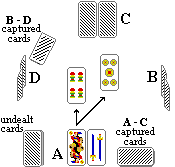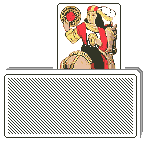This game is played with an Italian deck, which has 40 cards, divided into four suits,
called Coins, Cups,
Swords and Batons
(also referred to as Cudgels, or Clubs).
Each suit has values from 1 (ace) to 7; the three court cards are the knave, the cavalier
(or "horse") and the king, which are worth respectively 8, 9 and 10.
Although several patterns of Italian cards exist, the one more commonly used for playing
Scopa is the Piacentine deck, which the illustrations
in this page refer to, adopted by most areas of central Italy.
Obviously, any 40-card deck may be used for playing this game. Spanish packs only need to
drop the 8's and 9's. If using an international deck, instead, 8's, 9's and 10's need to
be taken out, and the queen will act as a cavalier (or horse), while the suit of Diamonds
will replace the suit of Coins. This is a common situation, since a few Italian regional
decks are made of 40 cards with French suits, and therefore the same changes have to be made
to play the game.
|
 |

forming couples |
Scopa is best enjoyed by four players, but it can be played by two, three or even six players.
When four people take part, couples (or teams) are usually formed by the players sitting in
front of each other, i.e. A-C and B-D as in the picture on the left.
In any other case, the game is played individually.
Scopone Scientifico, instead, is only played by four players, who form
couples, as explained above.
|
BASIC RULES OF SCOPA GAMES
Scopa, meaning "sweep, broom", is a family of
popular Italian games, played in most regions of the country. It is believed to be at least
400 years old, but probably dates further back in time.
There are two main versions of the game, the classic Scopa also known as
Scopetta ("small Scopa") or Three-Card Scopa, and
the most widespread version known as Scopone Scientifico ("big scientific Scopa"),
which requires a little more practice and memory to be played well, but both games are
very easy to learn.
What changes in the different versions is mainly the number of cards dealt at the beginning
of the game, since all other rules and goals are basically the same.
Games start with the deal of a number of covered cards to all players: three at a time
in Scopa, and ten all together in Scopone Scientifico. In the
first version, four cards are turned face up from the pile, ready to be captured, while in the
second version this does not happen, and the game has to start with a discard.
The cards turned face up on the table, either coming from the opening arrangement or, later on,
from the players' discards, are the ones which may be captured in turn by using the cards held in hand.
If a capture cannot be made, one of the player's cards must be discarded in any case, and
placed face up with the others, thus increasing the choice of cards which the following player
may capture.
CAPTURES
All captures are based on the value of cards. For example:
| a 5... |  | ...may capture another 5 |  |
|
| an ace... |  | ...may capture another ace |  |
More cards may be captured at the same time, if their sum is equals to the value of the card played.
For example:
| a 7... |  | ...may capture a 5 and a 2 |   |
|
| a 10 (king)... |  | ...may capture a 1 (ace) and a 9 (horse) |   |
The player is free to choose what to capture, if the cards on the table allow him to do so.
For example, if the ones on the table are...




a 9  could capture either
could capture either 
 or
or 

But if on the table there is a card whose value matches the one played, the player is not
free to choose: he must take the single matching card.
For example, if the following cards are on the table...



a 9  can only capture the other 9
can only capture the other 9  and NOT
and NOT 

During the game, a variable number of cards may be on the table, from a minimum of one to
four, five, or sometimes even more.
Players are not forced to capture, if they don't want to do so, but
it is not allowed to discard a card which would make a capture and leave it on
the table.
If a player who is capturing "sweeps" the table, leaving it without cards,
he scores a scopa, worth 1 point.
Other points are scored:
The winner is the player (or the team) who first reaches a given total of points, usually
11 or 21. This can require a variable number of games.
SCOPA
The dealer shuffles the cards, and asks the player on his left to cut the pack.
He then deals three cards to each player, starting from the one on his right, and ending
with himself.
Finally, the dealer turns face up four cards, placing them in the middle of the
table.
The remaining pile is kept close to the dealer.

|
|
SCOPONE SCIENTIFICO
The dealer shuffles the cards, and asks the player on his left to cut the pack.
He then deals ten cards to each player, starting from the one on his right, and ending
with himself, usually giving three to each, then three more, then the last four.
Therefore, no cards are turned face up, and no pile is left.
 |
At the end of each game, the new dealer will be the next player in anti-clockwise direction
(i.e. the one to the right of the previous dealer).
Note that in Scopa, as well as in most other Italian card games, turns are taken in anti-clockwise
direction.
THE GAME IN PROGRESS
SCOPA
The player to the right of the dealer is the first one who plays:
according to the cards he holds in hand, he tries to capture one or more cards on the table.
If he suceeds in doing so, he takes the cards and places them in front of himself (or in
front of his partner), face down.
Instead, if he cannot make a capture, he will simply discard one of his cards.
The player on his right (the dealer's partner) will take his turn, and so on, until each
player has no cards left in hand. At this point, the dealer will give another three cards to
each player, and the game continues until all cards have been played. |
|
SCOPONE
The player to the right of the dealer is the first one who plays, but since there are no
cards to capture yet, he can only discard one. Obviously, he will choose a value which
he has as a double or triple, so to reduce the chance for the next player to capture it.
The player on his right takes his turn, and may capture this card, thus scoring a "scopa" (see further
down), or he too will have to discard, so the cards on the table will be two.
The third player takes his turn, and so on until all 40 cards have been played.
|
| |
In both games, the rules according to which captures are made are the ones explained above
in the
"Basics" paragraph.
The captured cards are usually kept by players in front of them, face down, and should not
be handled or browsed during the game. In 4-player
Scopa and in
Scopone, only two players keep the captured cards (one for each team), so when
the other player makes a capture, he hands the cards to his partner.
Partners are not allowed to let the other player know which cards they hold in hand. If the
players are experienced, they might symbolically communicate, for example by making specific
discards in particular situations, but they should never openly advice their partner, or
suggest which card should be played, or make similar comments concerning the game.

this game is in progress:
player A can capture 4 and 5
with his 9, thus scoring a scopa |
When a player by making a capture takes all cards on the table (i.e. "sweeps" the table),
he scores a scopa. The card which obtained this point
is placed face up crossing the pile of captured ones, as a
visible reminder.
After a scopa has been made, the next player
(i.e. B in this example) has no opportunity to make a capture, and has to discard:
this will prove a very favourable circumstance for the same team (i.e. player C) to
score another scopa straight away.
|

the pile of captured cards after
the scopa will look like this |
The very last card of the game, always played by the dealer, is not allowed to score a
scopa, so in the case his card succeeds in
"sweeping" the table, this capture is always considered as an ordinary one.
